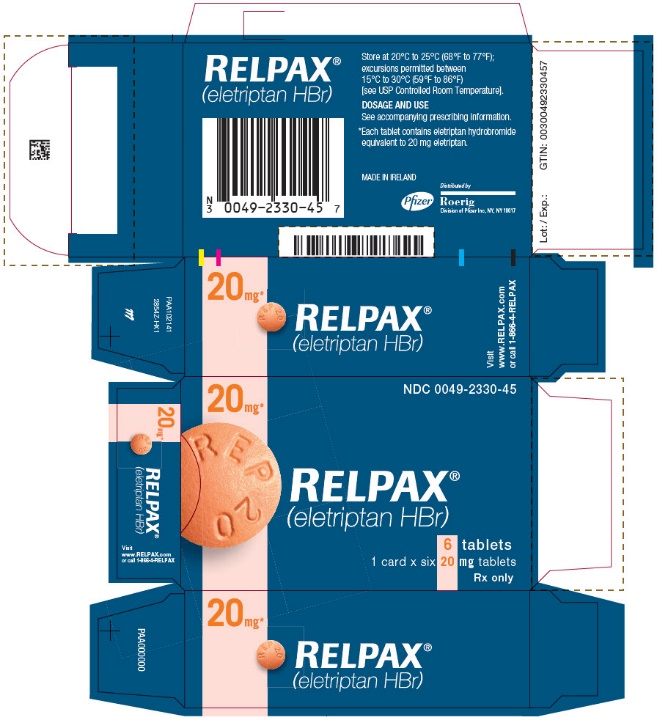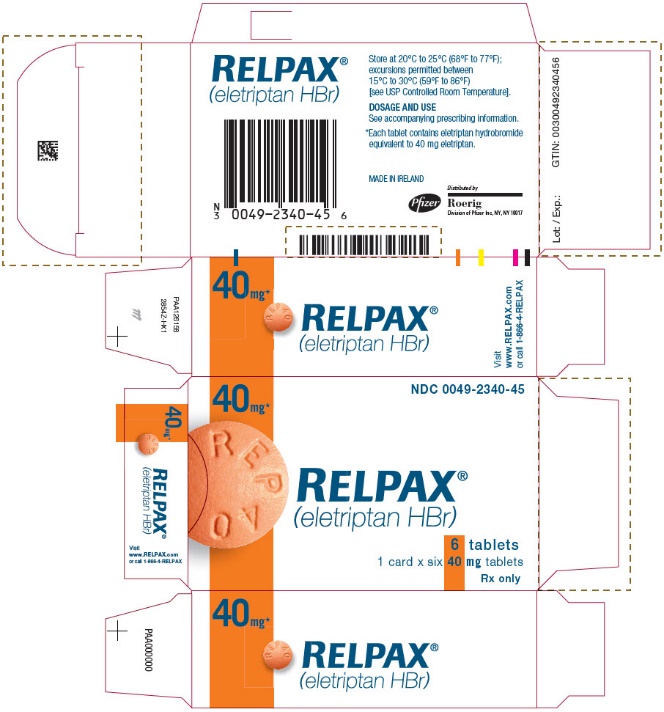Relpax
Generic name: eletriptan
Drug class: Antimigraine agents
Medically reviewed by A Ras MD.
What is Relpax?
Relpax is a prescription medicine used to treat acute migraine headaches with or without aura in adults. Relpax is for people who have been diagnosed with migraine headaches. Relpax is not used to prevent or decrease the number of migraine headaches you have.
It is not known if Relpax is safe and effective to treat cluster headaches. It is not known if Relpax is safe and effective in children.
Description
RELPAX (eletriptan hydrobromide) tablets contain eletriptan hydrobromide, which is a selective 5-hydroxytryptamine 1B/1D (5-HT1B/1D) receptor agonist. Eletriptan hydrobromide is chemically designated as (R)-3-[(1-Methyl-2-pyrrolidinyl)methyl]-5-[2-(phenylsulfonyl)ethyl]-1H-indole monohydrobromide, and it has the following chemical structure:

The empirical formula is C22H26N2O2S . HBr, representing a molecular weight of 463.43. Eletriptan hydrobromide is a white to light pale colored powder that is readily soluble in water.
Each RELPAX Tablet for oral administration contains 24.2 or 48.5 mg of eletriptan hydrobromide equivalent to 20 mg or 40 mg of eletriptan, respectively. Each tablet also contains the inactive ingredients microcrystalline cellulose NF, lactose monohydrate NF, croscarmellose sodium NF, magnesium stearate NF, titanium dioxide USP, hypromellose, triacetin USP and FD&C Yellow No. 6 aluminum lake.
Mechanism of Action
Eletriptan binds with high affinity to 5-HT1B, 5-HT1D and 5-HT1F receptors, has modest affinity for 5-HT1A, 5-HT1E, 5-HT2B and 5-HT7 receptors.
Migraines are likely due to local cranial vasodilatation and/or to the release of sensory neuropeptides (vasoactive intestinal peptide, substance P and calcitonin gene-related peptide) through nerve endings in the trigeminal system. The therapeutic activity of RELPAX for the treatment of migraine headache is thought to be due to the agonist effects at the 5-HT1B/1D receptors on intracranial blood vessels (including the arterio-venous anastomoses) and sensory nerves of the trigeminal system which result in cranial vessel constriction and inhibition of pro-inflammatory neuropeptide release.
What is the most important information I should know about Relpax?
Relpax can cause serious side effects, including:
Heart attack and other heart problems. Heart problems may lead to death.
Stop taking Relpax and get emergency medical help right away if you have any of the following symptoms of a heart attack:
- discomfort in the center of your chest that lasts for more than a few minutes, or that goes away and comes back
- chest pain or chest discomfort that feels like an uncomfortable heavy pressure, squeezing, fullness, or pain
- pain or discomfort in your arms, back, neck, jaw, or stomach
- shortness of breath with or without chest discomfort
- breaking out in a cold sweat
- nausea or vomiting
- feeling lightheaded
Relpax is not for people with risk factors for heart disease unless a heart exam is done and shows no problem. You have a higher risk for heart disease if you:
- have high blood pressure
- have high cholesterol levels
- smoke
- are overweight
- have diabetes
- have a family history of heart disease
- are a female who has gone through menopause
- are a male over age 40
Serotonin syndrome. Serotonin syndrome is a serious and life-threatening problem that can happen in people taking RELPAX, especially if Relpax is taken with anti-depressant medicines called selective serotonin reuptake inhibitors (SSRIs) or serotonin and norepinephrine reuptake inhibitors (SNRIs).
Ask your doctor or pharmacist for a list of these medicines if you are not sure.
Call your doctor right away if you have any of the following symptoms of serotonin syndrome:
- mental changes such as seeing things that are not there (hallucinations), agitation, or coma
- fast heartbeat
- changes in blood pressure
- high body temperature
- tight muscles
- trouble walking
- nausea, vomiting, or diarrhea
Who should not take Relpax?
Do not take Relpax if you:
- have heart problems or a history of heart problems
- have or have had a stroke or problems with your blood circulation
- have hemiplegic or basilar migraines. If you are not sure if you have these types of migraines, ask your doctor
- have narrowing of the blood vessels in your legs, arms, stomach, or kidney (peripheral vascular disease)
- have ischemic bowel disease
- have uncontrolled high blood pressure
- have taken any of the following medicines in the last 24 hours:
- other “triptans” or triptan combination products such as:
- almotriptan (Axert)
- sumatriptan and naproxen sodium, (Treximet)
- frovatriptan (Frova)
- zolmitriptan (Zomig)
- naratriptan (Amerge)
- rizatriptan (Maxalt)
- sumatriptan (Imitrex)
- ergotamines such as:
- Bellergal-S
- Ergomar
- Cafergot
- Wigraine
- dihydroergotamines such as:
- D.H.E. 45 or Migranal or methysergide (Sansert)
- other “triptans” or triptan combination products such as:
- have taken the following medicines within the last 72 hours:
- ketoconazole (Nizoral)
- clarithromycin (Biaxin)
- itraconazole (Sporanox)
- ritonavir (Norvir)
- nefazodone (Serzone)
- nelfinavir (Viracept)
- troleandomycin (TAO)
- are allergic to eletriptan or any of the ingredients in Relpax. See the end of this guide for a complete list of ingredients in Relpax.
What should I tell my healthcare provider before taking Relpax?
Before you take Relpax, tell your doctor if you:
- have heart problems or family history of heart problems or stroke
- have high blood pressure
- have high cholesterol
- have diabetes
- smoke
- are overweight
- are a female who has gone through menopause
- have kidney problems
- have liver problems
- are pregnant or plan to become pregnant. It is not known if Relpax will harm your unborn baby.
- are breastfeeding or plan to breastfeed. Relpax passes into your breast milk and may harm your baby. Talk to your doctor about the best way to feed your baby if you take Relpax.
Tell your doctor about all the medicines you take, including prescription and over-the-counter medicines, vitamins, and herbal supplements. Your doctor will decide if you can take Relpax with your other medicines. Relpax and other medicines may affect each other causing side effects.
Especially tell your doctor if you take anti-depressant medicines called:
- selective serotonin reuptake inhibitors (SSRIs)
- serotonin and norepinephrine reuptake inhibitors (SNRIs)
Ask your doctor or pharmacist for a list of these medicines if you are not sure.
Know the medicines you take. Keep a list of them to show your doctor or pharmacist when you get a new medicine.
How should I take Relpax?
- Take Relpax exactly as your doctor tells you to take it.
- Your doctor will tell you how much Relpax to take and when to take it.
- Your doctor may change your dose if needed. Do not change your dose without first talking to your doctor.
- Take 1 Relpax tablet as soon as you feel a migraine coming on.
- If you do not get any relief after your first Relpax tablet, do not take a second tablet without first talking with your doctor.
- If your headache comes back or you only get some relief from your headache, you can take a second tablet 2 hours after the first tablet.
- Do not take more than a total of 80 mg of Relpax tablets in a 24-hour period.
- If you take too much Relpax, call your doctor or go to the nearest hospital emergency room right away.
- You should write down when you have headaches and when you take Relpax so you can talk to your doctor about how well Relpax is working for you.
What should I avoid while taking Relpax?
Relpax can cause dizziness, weakness, or drowsiness. If you have these symptoms, do not drive a car, use machinery, or do anything where you need to be alert.
What are the possible side effects of Relpax?
Relpax may cause serious side effects. See “What is the most important information I should know about Relpax?”
These serious side effects include:
- changes in color or sensation in your fingers and toes (Raynaud’s syndrome)
- stomach and intestinal problems (gastrointestinal and colonic ischemic events). Symptoms of gastrointestinal and colonic ischemic events include:
- sudden or severe stomach pain
- stomach pain after meals
- weight loss
- nausea or vomiting
- constipation or diarrhea
- bloody diarrhea
- fever
- problems with blood circulation to your legs and feet (peripheral vascular ischemia). Symptoms of peripheral vascular ischemia include:
- cramping and pain in your legs or hips
- feeling of heaviness or tightness in your leg muscles
- burning or aching pain in your feet or toes while resting
- numbness, tingling, or weakness in your legs
- cold feeling or color changes in 1 or both legs or feet
- medication overuse headaches. Some people who take too many Relpax may have worse headaches (medication overuse headache). If your headaches get worse, your doctor may decide to stop your treatment with Relpax.
The most common side effects of Relpax include:
- dizziness
- nausea
- weakness
- tiredness
- drowsiness
Tell your doctor if you have any side effect that bothers you or that does not go away. These are not all the possible side effects of Relpax. For more information, ask your doctor or pharmacist.
Call your doctor for medical advice about side effects. You may report side effects to the FDA at 1-800-FDA-1088.
General information about the safe and effective use of Relpax
Medicines are sometimes prescribed for conditions that are not mentioned in patient information leaflets. Do not use Relpax for a condition for which it was not prescribed. Do not give Relpax to other people, even if they have the same symptoms you have. It may harm them.
This Patient Information summarizes the most important information about Relpax. If you would like more information about Relpax, talk with your doctor. You can ask your doctor or pharmacist for information on Relpax that is written for health professionals.
For more information, call 1-866-4RELPAX (1-866-473-5729) or go to www.RELPAX.com.
How should I store Relpax?
Store Relpax at room temperature between 68°F to 77°F (20°C to 25°C).
What are the ingredients in Relpax?
Active ingredient: eletriptan hydrobromide
Inactive ingredients: microcrystalline cellulose, lactose monohydrate, croscarmellose sodium, magnesium stearate, titanium dioxide, hypromellose, triacetin, and FD&C Yellow No. 6 aluminum lake.
Label
PRINCIPAL DISPLAY PANEL – 20 MG TABLET BLISTER PACK CARTON
- 20mg*
NDC 0049-2330-45 - RELPAX®
(eletriptan HBr) - 6 tablets
1 card x six 20 mg tablets
Rx only


PRINCIPAL DISPLAY PANEL – 40 MG TABLET BLISTER PACK CARTON
- 40mg*
NDC 0049-2340-45 - RELPAX®
(eletriptan HBr) - 6 tablets
1 card x six 40 mg tablets
Rx only


SRC: NLM .